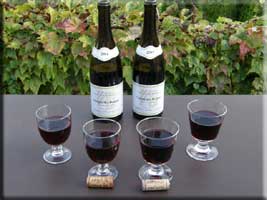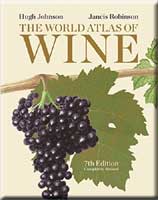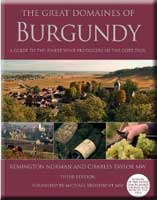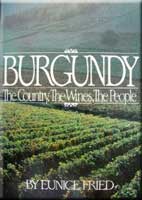|
|
Burgundy has been my favorite wine ever since I graduated from rosé as I graduated from college. I thank my uncle for introducing me to some of the best (Musigny, Echézeaux, and Corton). After his introduction, I wandered around Burgundy on many vacations, seeking the lesser known vineyards and lesser known winemakers, looking for bargains. Burgundy stretches from Chablis in the NW, down through the Cote d'Or bracketing Beaune, through Rully, Mercurey, Givry, and Montagny, to the Mâconnais, to Beaujolais. The best wines come from the Cote d'Or and most people would further specify that the northern part, the Côte de Nuits named after the village of Nuits-St-Georges, has the very best. Here all red wines are made from the Pinot Noir grape and all white wines are chardonnay.
Bordeaux producers were classified in 1855 mostly based on the prices fetched over the previous decade or so. This has generally held up well, possibly because it is self-reinforcing. If Chateau Nuits-St-Waga-Waga is top-rated, it will command a higher price, allowing the owner to hire the best winemaker. He will be able to have a swarm of experienced harvesters picking the ripest clusters and leaving the others. He can afford new oak barrels. And indeed, the premium one pays for the best four (now five with the elevation of Mouton Rothschild in 1973) has increased. That sentence, however, has a hint that the 1855 classification was not perfect in that Mouton was overlooked. Less well known is that M. Lavalle produced a classification of Burgundy in that same year, taking price into account, but basing it on location of the vineyard, not the producer. This is somewhat related to the fact that during the French revolution, the large estates in Bordeaux tended to remain intact while the large estates in Burgundy (frequently owned by the church) were divided among the revolutionaries.
This in turn led to the rise of negotiants who would buy grapes or barrels of freshly squeezed grape juice and make wine with their name and the name of the location of the grapes. Thus, it becomes important to know both the ranking of the various locations and the reputation of the negotiant. Most of the Cote d'Or runs north-south on the eastern slope of a range of low hills. It is generally agreed that the vines must be stressed in order to produce the best wine. Rain runs down the hill carrying soil with it. The vines on the hill must send roots deeper to get rain and find nutrients in the sparse soil. The vines on the flats have an easier time of it, soaking up lots of water which dilutes their taste. Thus the best vineyards are generally on the hill where catching the first rays of the rising sun also helps to prevent frost.
So which are the best vineyards? Chambertin, St Denis, Musigny, Echézeaux, Vougeot, Corton, Romanée, Montrachet, and a few others were named Grand Crus and given the right to put their name on the label. An even greater number vineyards were named Premier Crus and given the right to put the commune name and their vineyard name of Prenier Cru on the label. A third group of vineyards can use the commune name and even add a vineyard name in very small print. The last group cannot use the commune name but only call themselves Borgogne.
|

|

Somewhat cynically, shortly after this was decided the town of Gevrey appended the name of its most famous vineyard to the commune name, becoming Gevrey-Chambertin. Most other towns followed suit and Morey became Morey-St Denis, Chambolle became Chambolle-Musigny, Vosne became Vosne-Romanée, Aloxe became Aloxe-Corton, and as Montrachet crosses the border between Chassagne and Puligny, they became Chassagne-Montrachet and Puligny-Montrachet. The reason for this is that any wine grown in what previously was Gevrey now could proudly sport the name Gevrey-Chambertin on its label, etc. Caveat emptor.
So what should you drink? The vintage year gives easy answers. For red burgundies, 2009, 2005, and 2002 are very good. Avoid 2007 and 2004. For white burgundies, 2009 was a great year and all the others are OK back to 2003 which was not very good and probably too old anyway.
In mid-2011 the best Grand Crus are into four figures. Lesser ones dip down to $100 or so per bottle. We bought Jadot's 2008 Clos de la Roche for $160 and his Corton Clos du Roi for $100 from Zachy's in late 2010. Better Premier Crus easily top $100 per bottle and lesser ones are drop to $25. You rarely see advertisements for wines of this caliber, consequently price is a pretty good indication of quality. Your ability to price-shop, especially for Grand Crus, is limited by a very small supply. Total burgundy production is about 10% of that from Bordeaux and the vast majority of Burgundy comes from Macon and Beaujolais, not the Cote d'Or. The grand Crus are a very small portion of that tiny portion.

|
Where are the bargains? We look to the vineyards quite close to the big names. Savigny-les-Beaune and Pernand-Vergelesses are behind Beaune and Aloxe-Corton. St-Aubin hides behind Montrachet. In good years, they make very good wine but can't get the prices that the big names command. To the south, Santenay is the last appellation in the Cote d'Or and, as such, generally sells for a bit less. Further south is the Chalonnaise containing Rully, Mercurey, Givry, and Montagny. Rully and Montagny make some very good white wines while Givry and Mercurey are known for their reds. However, all four make reds and whites.
On the right is an impromptu tasting of a 2005 Chorey-les-Beaune and a 2004 Savigny-les-Beaune from Arnoux Père et Fils. The photo was taken from our second floor balcony at La Tuiliere in Cadenet (Vaucluse), France. According to Parker the Arnoux are average producer and not to be confused with Robert Arnoux, an excellent producer.
|

|

As mentioned earlier, the small parcel sizes led to negotiants who buy grapes, must, or barrels of wine producing a bottle with the location, year, and their name. Good and trustworthy negotiants are another approach to finding a good wine. We have always liked Drouhin, Faiveley, Leroy, Jadot, Remoissenet, and Latour - probably in that order. Bouchard has improved in my wine drinking lifetime. There are hundreds of smaller producers, but the only way to sort them out is explained in the next paragraph.
The final way to get the wine you want is to ask the wine steward in the restaurant or the staff in the wine shop. That person should know their inventory and can steer you to the best wine they have for you. I know this doesn't always work. I've ordered Cabernet Sauvignon and and received Sauvignon Blanc from a waitress in a restaurant. Seeking someone knowledgeable about wines in a supermarket approximates Diogenes in his quest for an honest man. My advice, avoid those restaurants and don't expect any help in a supermarket. Develop a relationship with a reliable wine shop. They can steer you toward the wine that you would like best in the price range you specify. On the island there are several. We tend toward Select Wine Cellar, although Vinissimo, Le Gout du Vin, and Bacchus have good wine and personnel.
Obviously, when you are back in the US, you should establish a relationship with a good local store. Lacking that, or in addition to that, check out Lot18. They offer short-lived sales on various wines.
There are several books to recommend. The first is probably the best overall guide to the wines of the entire world. The maps are spectacular, especially the ones for Burgundy. The second is probably the best discussion of the best producers and climats in Burgundy and the third is about a woman I visited in 1987. It gives an intimate look at the people of Burgundy.
|
The World Atlas of Wine by Hugh Johnson, Jancis Robinson ($31.50, $22 used)
- The World Atlas of Wine is something of a dream-team production. The names Hugh Johnson and Jancis Robinson alone recommend any book on which they appear. The fifth edition (in 30 years) of this astonishingly successful book lives up to, and surpasses, its predecessors. In 350 densely packed but never clotted pages the authors manage the extraordinary feat of characterizing wine production throughout the world, from Vancouver Island to Japan--Buddhists first planted vines in that inhospitably precipitous, monsoon-lashed land over a 1,000 years ago. After a substantial introductory section dealing with the history of wine, its making, storage, and enjoyment, we're off. Starting with (where else?) France and Burgundy, each wine area is summarized in terms of its geography, climate, and preferred vines and the appellations, laws, and traditions that govern production. The discussion of Pomerol, for example, tells you a great deal in one short page. Even since 1994, when the fourth edition came out, vast changes have swept the wine world, and many parts of the atlas have been correspondingly completely reworked. South America, Canada, Southern France, Italy, Greece, Eastern Europe, and the Eastern Mediterranean are among the areas that have benefited. The regional maps that form the core of the book are a triumph of clarity. The whole production constitutes a brilliant achievement of organization and synthesis, forming an indispensable resource for any wine lover at all interested in where the wine they drink comes from and why it tastes the way it does.
There is an 2006 edition available for about $23 (new) and $2 (used) and a 2005 pocket edition for about $3 used.
|

|
|
The Great Domaines of Burgundy: A Guide to the Finest Wine Producers of the Cote d'Or, Third Edition by Remington Norman and Charles Taylor
- ($23 new) I have a copy of Parker's
Burgundy: A Comprehensive Guide to the Producers, Appellations, and Wines but I cannot recommend it at this time as it has not been updated since 1990 when it was first published. There is also the problem that Parker seems to like Bordeaux and Rhone wines rather than Burgundies. So, get this book. Subdivided into hundreds of domaines, often family-run and small in size, Burgundy can seem forbiddingly fragmented even to wine experts. Now, acclaimed wine writers Remington Norman and Charles Taylor help wine lovers unravel the mystery of this grape. In compiling this revised version of their much-praised book, they revisited all the domaines that appeared in previous editions, along with numerous rising stars, to select the very best-and remove those that no longer make the grade. Norman and Taylor spoke to the winemakers about their grapes, their soil, and their techniques and, of course, sampled their wines. In addition to a domaine-by-domaine guide with coverage of the region's microclimates, most important grapes, wine styles, there are tips on buying, storing and tasting wine and a rundown of recent vintages.
|

|
|
Burgundy: The Country, the Wines, the People by Eunice Fried
- ($4 used, essentially you pay for shipping) From Publishers Weekly:
Wine writer Fried views Burgundy, long celebrated for its fine wine and food, as a special, mystical place. She captures the spirit of the region so well that readers will forgive the occasional awkward and exaggerated moments in her prose. Fried begins with a profile of Becky Wasserman, an American who has infiltrated the wine business in Burgundy; through her experiences the reader is introduced to the world of winemaking, from its history in the area and techniques of the trade to the personalities of local winemakers and merchants. The historical perspective is intriguing, and Fried's comparison of a wine-producing monastery of the Middle Ages and its contemporary offspring lends weight to the French maxim "Plus ca change, plus la meme chose." This is enticing reading for the wine lover, Francophile, or Burgundy-bound traveler. On a personal note, I received this book from an executive at Harper & Row when it was published in 1986. Becky founded Le Serbet and became a most rare thing, a female, American negotiant in Burgundy. I wrote to her and visited her farmhouse in 1987 for pleasant lunch and an outstanding wine-tasting experience. The big farmhouse dining table was 4' by 16'. The six of us were dining at one end and the rest of the table was loaded with wines to taste. The farmhouse was located in Bouilland about ten miles further up the Rhoin River from Savigny-les-Beaune. It's a small town but has the Hostellerie Du Vieux Moulin, a lovely old mill converted into at hotel sporting a one star restaurant.
|

|
|








